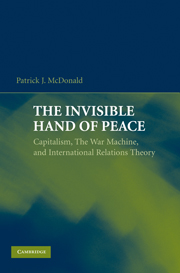Book contents
- Frontmatter
- Contents
- List of Tables
- Acknowledgments
- 1 American Grand Strategy and the Liberal Peace
- 2 Liberal International Relations Theory on War
- 3 Releasing the Invisible Hand
- 4 Liberal Economic Institutions and Peace in the Twentieth Century
- 5 Free Trade and Peace in the First Era of Globalization
- 6 From Rivalry to Friendship
- 7 The Achilles' Heel of Liberal International Relations Theory?
- 8 Peace Across the Taiwan Strait?
- 9 The Invisible Hand or the Ballot Box?
- 10 Capitalism and America's Peaceful Market Power
- References
- Index
10 - Capitalism and America's Peaceful Market Power
Published online by Cambridge University Press: 05 June 2012
- Frontmatter
- Contents
- List of Tables
- Acknowledgments
- 1 American Grand Strategy and the Liberal Peace
- 2 Liberal International Relations Theory on War
- 3 Releasing the Invisible Hand
- 4 Liberal Economic Institutions and Peace in the Twentieth Century
- 5 Free Trade and Peace in the First Era of Globalization
- 6 From Rivalry to Friendship
- 7 The Achilles' Heel of Liberal International Relations Theory?
- 8 Peace Across the Taiwan Strait?
- 9 The Invisible Hand or the Ballot Box?
- 10 Capitalism and America's Peaceful Market Power
- References
- Index
Summary
The national security challenges facing the United States in the aftermath of September 11 have again exposed the historic struggle for the heart of American foreign policy. In Diplomacy, Henry Kissinger (1994) used the presidencies of Theodore Roosevelt and Woodrow Wilson to embody two sets of competing principles that have often pulled American foreign policy in opposite directions. On the one hand, America, since its independence, has drawn on and remained committed to a broad base of liberal ideas in its political, social, economic, and cultural life that have shaped its relationship with the world. Perhaps most dramatically, they guided Wilson's vision launched at the Versailles peace talks for a democratic global political order that would help the world to escape the plague of war. Both in practice and rhetoric, his legacy indelibly shaped the American century and guided the United States in its sustained political and military campaigns against fascism, communism, and now Islamic fundamentalism.
However, the pursuit of this liberal vision has often been reigned in by the competing conservatism of a cold-blooded realpolitik that Kissinger argued characterized the Theodore Roosevelt administration. This tradition would allow Franklin Roosevelt to overlook the tyranny of Stalin's communist regime to achieve victory in the larger struggle against Nazi Germany. Nixon could similarly exploit the split within the communist bloc and enlist China in the struggle against the Soviet Union.
- Type
- Chapter
- Information
- The Invisible Hand of PeaceCapitalism, the War Machine, and International Relations Theory, pp. 284 - 308Publisher: Cambridge University PressPrint publication year: 2009

